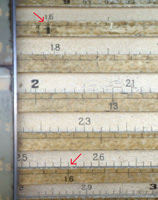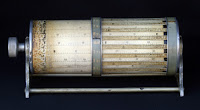
The cylindrical slide rule at right was made by the Swiss company Loga, probably between 1915 and 1930. It is about 8 inches (21 cm) wide at its longest point. The scales are effectively 96 inches long, divided into 20 sections arrayed around the cylinder. Despite its compact size, this slide rule can provide results accurate to at least one part in 2,000, or roughly 3.5 digits.
I had several purposes for taking these photos. The first is simply to record the slide rule’s appearance before cleaning, for comparison with the appearance after cleaning. Second, I’ve been experimenting with how to photograph slide rules, and this one is particularly challenging because it is so three-dimensional. These photographs were taken in a homemade shadow-box, all at f32 and times ranging from 0.7 seconds to 4 seconds, with the effective sensor speed at 100 ASA. I used a Canon EOS 10D with a 160 mm (effective) macro lens and a polarizing filter. The lighting was natural sunlight on a cloudy, hazy day with the shadow box facing due north. By observation, the depth of field achieved is greater than 4 inchs — more than enough to render the entire slide rule in focus when shot from an angle.

The large photo at right (and the magnified portion of it in the smaller photo) show the same slide rule approximately head-on (minimizing the depth of field requirement). Everything else is the same as above.
Look at the small photo (click on it to enlarge it). The slide is set to multiply 16 times something. The red arrow in the upper left shows how the 16 is set. The lower arrow shows how you can read the answer for 16 x 16, or 256.

No comments:
Post a Comment